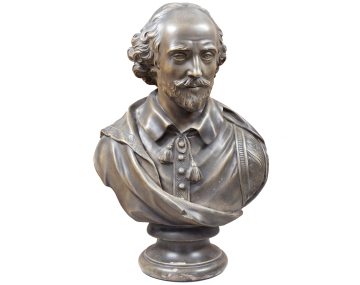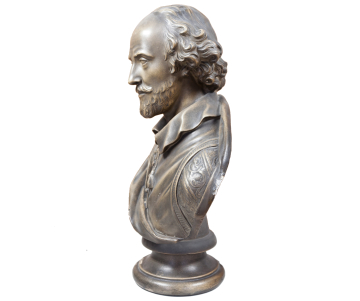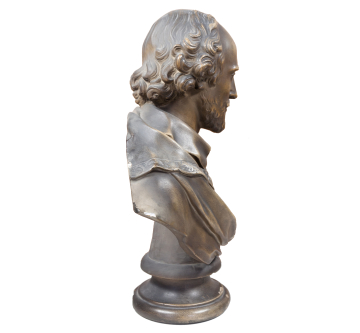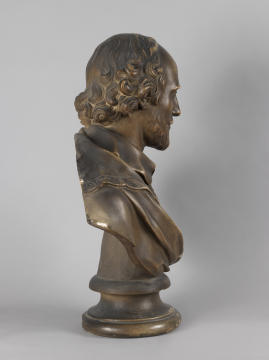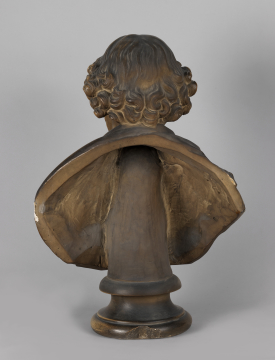Explore Collections


You are here:
CollectionsOnline
/
Bust of William Shakespeare, after his monument in Westminster Abbey
Browse
After Peter Scheemakers (1691 - 1781), sculptor
Attributed to John Cheere (1709 - 1787), sculptor
Giovanni Battista [John Baptist] Gianelli (fl. 1777-1814), maker
Italian cast-maker with a plaster cast manufactory/shop in the Cock Lane area.
Attributed to John Cheere (1709 - 1787), sculptor
Giovanni Battista [John Baptist] Gianelli (fl. 1777-1814), maker
Italian cast-maker with a plaster cast manufactory/shop in the Cock Lane area.
Bust of William Shakespeare, after his monument in Westminster Abbey
Plaster cast
Museum number: SC68
On display: Staircase - second to third floor (pre-booked tours only)
All spaces are in No. 13 Lincoln's Inn Fields unless identified as in No. 12, Soane's first house.
For tours https://www.soane.org/your-visit
Curatorial note
This bust is inspired by the figure of Shakespeare on the poet's monument, designed by William Kent, in Westminster Abbey which was the sculptor Peter Scheemakers' most famous work, dated 1740. Shakespeare is depicted standing cross-legged leaning his right elbow on a pile of three books, his head bent slightly to the right. Scheemakers based the head on the so-called 'Chandos' portrait of Shakespeare in the National Portrait Gallery (NPG1). The Shakespeare monument was frequently reproduced in reduced scale ceramic versions during the 18th century.
A marble bust in the Royal Collection identical to this plaster is attributed to John Cheere (1709-1787) and said to have been made in 1762 (Royal Collection no. RCIN 36980). Cheere made a full-size copy in lead of Scheemakers’ Westminster Abbey figure, in reverse, for the Stratford upon Avon Town Hall, commissioned by the celebrated actor David Garrick and dedicated as part of the Garrick Jubilee in 1769. (Some years after Cheere’s death another identical lead figure was presented to Drury Lane Theatre by Samuel Whitbread in 1809). Cheere therefore had every opportunity to study the monument and produce a marble bust based on the figure, moulds from which could then have been used to make multiple copies for sale.
A number of marble and plaster busts of very similar appearance are known. There is an almost identical plaster bust at the Garrick Club (but with a different socle detail between the bust and the circular pedestal) impressed with the makers name SHOUT, perhaps made by Robert Shout of Holborn (active 1787-1827) and a plaster by P. Sarti acquired by the Athenaeum Club as part of a group of plaster busts of famous men in 1830, which seems to have been based on Shout’s version (with an identical socle detail but without a circular pedestal). In the 1770s Josiah Wedgwood produced small-scale (14 inches high) busts in black basalt thought to be after Cheere, with slight variations in the costume detail from this plaster (see British Museum no. 1909,1201.100; Reilly, Wedgwood, 1989, I, p. 450 writes that Wedwgood was invoiced by Cheere for a cast [of a bust of Shakespeare] in February 1774).
This particular plaster was acquired by Soane in 1804 when an entry in his Note Book records that he bought ' ... A bust of Shakespeare of Gianelli ...' (no price is given). Gianelli was an Italian cast-maker working in London. Perhaps Gianelli may have had access to one of the multiples produced by the Cheere workshop at Hyde Park Corner and taken his own moulds - or perhaps he was authorised to sell Cheere plaster casts.
This plaster bust is shown in Shakespeare’s Flowers (SM P319) by Clara Maria Pope, a painting commissioned by Soane in the 1830s that hangs in the Morning Room on the second floor. It shows the original white finish of the cast – intended to look like a marble bust. This is today obscured by a later, darkened finish.
Shakespeare was buried in Holy Trinity Church, Stratford upon Avon in Warwickshire: the Shakespeare Recess created by Soane off the staircase at 13 Lincoln's Inn Fields contains a plaster copy of another famous bust of the poet - the one on his tomb there (SM SC18).
A marble bust in the Royal Collection identical to this plaster is attributed to John Cheere (1709-1787) and said to have been made in 1762 (Royal Collection no. RCIN 36980). Cheere made a full-size copy in lead of Scheemakers’ Westminster Abbey figure, in reverse, for the Stratford upon Avon Town Hall, commissioned by the celebrated actor David Garrick and dedicated as part of the Garrick Jubilee in 1769. (Some years after Cheere’s death another identical lead figure was presented to Drury Lane Theatre by Samuel Whitbread in 1809). Cheere therefore had every opportunity to study the monument and produce a marble bust based on the figure, moulds from which could then have been used to make multiple copies for sale.
A number of marble and plaster busts of very similar appearance are known. There is an almost identical plaster bust at the Garrick Club (but with a different socle detail between the bust and the circular pedestal) impressed with the makers name SHOUT, perhaps made by Robert Shout of Holborn (active 1787-1827) and a plaster by P. Sarti acquired by the Athenaeum Club as part of a group of plaster busts of famous men in 1830, which seems to have been based on Shout’s version (with an identical socle detail but without a circular pedestal). In the 1770s Josiah Wedgwood produced small-scale (14 inches high) busts in black basalt thought to be after Cheere, with slight variations in the costume detail from this plaster (see British Museum no. 1909,1201.100; Reilly, Wedgwood, 1989, I, p. 450 writes that Wedwgood was invoiced by Cheere for a cast [of a bust of Shakespeare] in February 1774).
This particular plaster was acquired by Soane in 1804 when an entry in his Note Book records that he bought ' ... A bust of Shakespeare of Gianelli ...' (no price is given). Gianelli was an Italian cast-maker working in London. Perhaps Gianelli may have had access to one of the multiples produced by the Cheere workshop at Hyde Park Corner and taken his own moulds - or perhaps he was authorised to sell Cheere plaster casts.
This plaster bust is shown in Shakespeare’s Flowers (SM P319) by Clara Maria Pope, a painting commissioned by Soane in the 1830s that hangs in the Morning Room on the second floor. It shows the original white finish of the cast – intended to look like a marble bust. This is today obscured by a later, darkened finish.
Shakespeare was buried in Holy Trinity Church, Stratford upon Avon in Warwickshire: the Shakespeare Recess created by Soane off the staircase at 13 Lincoln's Inn Fields contains a plaster copy of another famous bust of the poet - the one on his tomb there (SM SC18).
Literature
COMPARATIVE LITERATURE
Margaret Whinney, Sculpture in Britain 1530 to 1830, rev. J. Physick, London, 1988, no. 130 and p.190
Blog dated 17 January 2016 by the art historian David Bridgwater at bathartandarchitecture.blogspot.com discusses the various busts of Shakespeare in detail.
Helen Dorey, ‘Sir John Soane’s Casts as Part of his Academy of Architecture at 13 Lincoln’s Inn Fields’, in Frederiksen 2010, p.599
For Gianelli/Gianelli family see British bronze sculpture founders and plaster figure makers, 1800-1980. National Portrait Gallery, London [http://www.npg.org.uk/research/programmes/british-bronze-founders-and-plaster-figure-makers-1800-1980-1/british-bronze-founders-and-plaster-figure-makers-1800-1980-b.php] Accessed 23 March 2024.
Blog dated 17 January 2016 by the art historian David Bridgwater at bathartandarchitecture.blogspot.com discusses the various busts of Shakespeare in detail.
Helen Dorey, ‘Sir John Soane’s Casts as Part of his Academy of Architecture at 13 Lincoln’s Inn Fields’, in Frederiksen 2010, p.599
For Gianelli/Gianelli family see British bronze sculpture founders and plaster figure makers, 1800-1980. National Portrait Gallery, London [http://www.npg.org.uk/research/programmes/british-bronze-founders-and-plaster-figure-makers-1800-1980-1/british-bronze-founders-and-plaster-figure-makers-1800-1980-b.php] Accessed 23 March 2024.
Associated items
Comments
Copies of this Shakespeare bust are available from Haddonstone Ltd under licence from Soane Museum Enterprises as part of their Soane range.
Soane collections online is being continually updated. If you wish to find out more or if you have any further information about this object please contact us: worksofart@soane.org.uk
